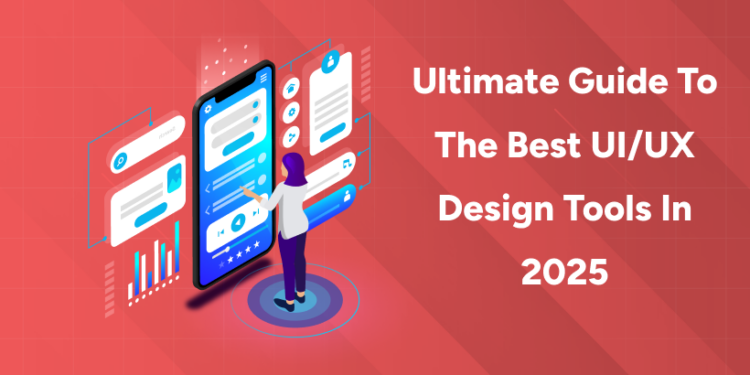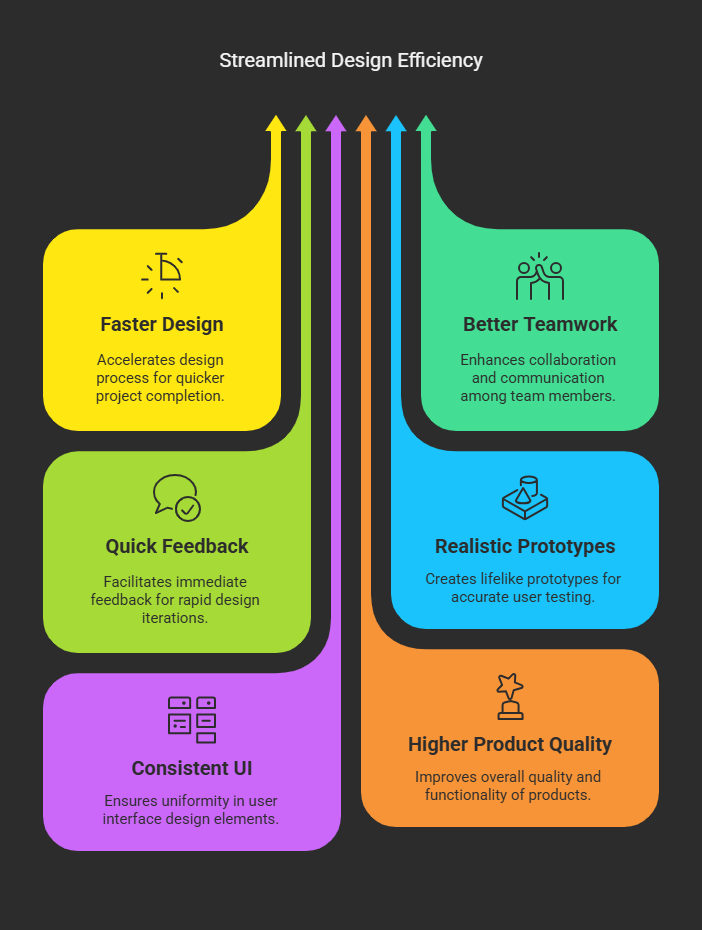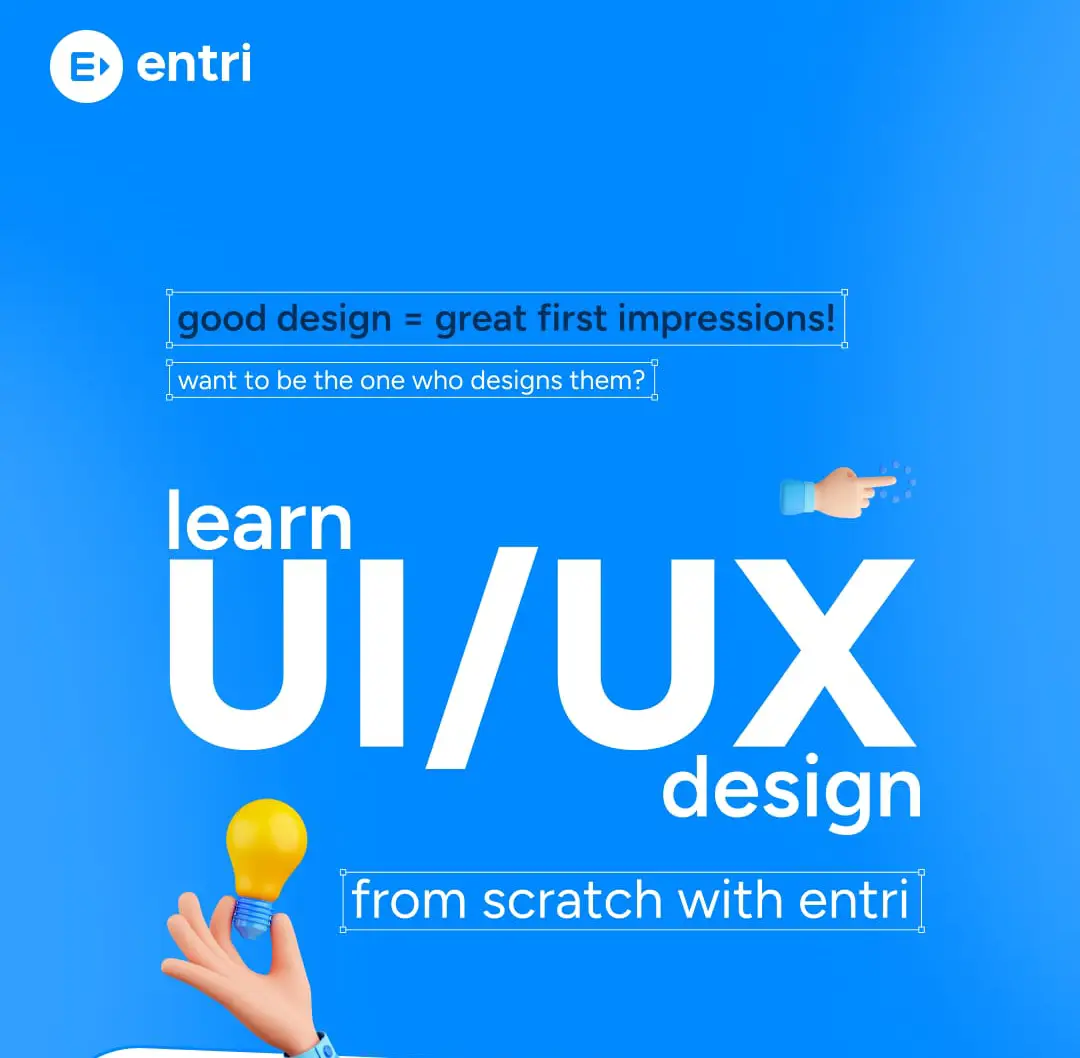Table of Contents
Are you a designer, developer, or product manager looking for the most efficient way to build beautiful and functional digital experiences? Then, you’re in the right place. This Ultimate Guide to the Best UI/UX Design Tools in 2025 will give you the top platforms shaping the way we design today—so that you can work smarter and not harder.
Ultimate Guide to the Best UI/UX Design Tools in 2025
Introduction
Did you know 94% of first impressions are design-related?
That means your UI/UX isn’t just important—it’s everything. In 2025, users expect fast, intuitive, and clean digital experiences, and the right design tools help you deliver exactly that. Whether you’re sketching a wireframe or building high-fidelity prototypes, having the right tool saves time and frustration.
Why it matters:
-
Better tools = better collaboration
-
Faster iterations = quicker launches
-
Smarter design = happier users
Here’s a quick look at what you’ll get in this guide:
| Section | What You’ll Learn |
|---|---|
| Why UI/UX Tools Matter | The role tools play in user experience |
| Top 10 Tools | Features, strengths, and best uses |
| Comparison Table | Side-by-side breakdown of all key tools |
| Choosing the Right Tool | How to pick based on your goals and workflow |
| FAQs | Fast answers to common tool-related questions |
Let’s dive into the tools defining great design in 2025.
Get Certified in UI/UX Design — Build User-Friendly Experiences with Confidence!
Why UI/UX Tools Matter
| Benefit | What It Helps With |
|---|---|
| Faster design | Speeds up wireframing and mockups |
| Real-time collaboration | Teams can work together live |
| Fewer dev handoff issues | Smoother transition from design to code |
| Design consistency | Reusable styles and components |
| Clear user flows | Easier to map and communicate UX |
| Rapid prototyping | Test interactions without code |
| Quick feedback loops | Stakeholders can comment instantly |
| Scalable design systems | Maintain uniformity across projects |
| Remote-friendly workflows | Cloud-based tools support global teams |
| Version control | Track changes and roll back easily |
| Early validation | Spot problems before development |
| Organized project files | Keep everything in one place |
| Higher product quality | Better UI/UX means fewer user complaints |
| Improved user satisfaction | Designs that feel intuitive and seamless |
| Reduced costs | Saves dev time and avoids redesigns |
These tools aren’t just nice to have—they’re essential for building products people actually enjoy using.
Top 10 UI/UX Tools in 2025
1. Figma
What it is: A cloud-based UI/UX design tool known for real-time collaboration.
-
Great for teams working remotely
-
Easy prototyping and developer handoff
-
Tons of plugins and community assets
-
Works directly in your browser
2. Adobe XD
What it is: Adobe’s vector-based tool for UI/UX design and prototyping.
-
Clean, fast interface
-
Strong integration with Photoshop and Illustrator
-
Auto-animate for smooth transitions
-
Ideal for those already in the Adobe ecosystem
3. Sketch
What it is: A macOS design tool focused on UI layouts and design systems.
-
Lightweight and intuitive
-
Great for static screens and component libraries
-
Strong plugin community
-
Best for solo designers or small teams on Mac
4. Framer
What it is: A high-fidelity interactive design tool built on React.
-
Turns prototypes into near-production code
-
Excellent for motion and interaction design
-
Ideal for design/dev collaboration
-
No-code options also available
5. UXPin
What it is: An advanced prototyping platform with real logic and components.
-
Ideal for complex user flows
-
Conditional interactions and variables
-
Supports design systems at scale
-
Geared toward UX-heavy projects
6. InVision Studio
What it is: A design and animation tool from the InVision suite.
-
Focuses on transitions and motion design
-
Works with InVision Cloud for feedback
-
Easy developer handoff
-
Usage has declined but still relevant for some
7. Penpot
What it is: The first open-source, web-based UI/UX design tool.
-
Free and self-hostable
-
Great Figma alternative for privacy-focused teams
-
Team-friendly and cross-platform
-
Ideal for organizations avoiding vendor lock-in
8. Axure RP
What it is: A powerful UX tool for building interactive, logic-driven prototypes.
-
Supports variables, conditions, and dynamic content
-
Useful for UX testing and simulations
-
Great for complex apps and systems
-
More advanced than most UI tools
9. Webflow
What it is: A visual web design platform that writes clean, exportable code.
-
Design and launch real websites visually
-
No-code, but powerful enough for devs
-
CMS and ecommerce features included
-
Ideal for marketing and portfolio sites
10. Maze
What it is: A remote user testing platform that integrates with design tools.
-
Test prototypes with real users
-
Collect heatmaps, click paths, and feedback
-
Fast validation without extra tools
-
Integrates with Figma, Adobe XD, Sketch
Comparison Table
| Tool | Platforms | Best For | Key Features | Price Model |
|---|---|---|---|---|
| Figma | Web, Desktop | Collaboration, Prototyping | Real-time edits, plugins, components | Freemium / Paid |
| Adobe XD | Mac, Windows | UI Design | Auto-animate, Adobe cloud integration | Subscription |
| Sketch | Mac | UI Layouts | Symbols, vector editing | Paid |
| Framer | Web, Desktop | Interactive Prototypes | React-based code, animations | Freemium / Paid |
| UXPin | Web | Complex Prototypes | Logic-based flows, design systems | Subscription |
| InVision | Web, Desktop | Handoff & Prototyping | Interactive mockups, team feedback | Freemium / Paid |
| Penpot | Web | Open Source UI/UX | Team collaboration, no vendor lock-in | Free |
| Axure RP | Windows, Mac | Advanced UX | Conditional flows, data-driven design | Subscription |
| Webflow | Web | Live Web Design | Visual coding, CMS | Freemium / Paid |
| Maze | Web | User Testing | Remote testing, analytics | Subscription |
Get Certified in UI/UX Design — Build User-Friendly Experiences with Confidence!
How to Choose the Right Tool
Step 1: Define Your Goals
- What are you designing?
- Web, mobile, or both?
- Static screens or interactive flows?
- Just visuals or full prototypes?
- Need user testing or not?
- Will devs use the output?
Step 2: Know Your Team and Workflow
- Solo or team?
- Designers only or cross-functional?
- Remote or in-house?
- Need live collaboration?
- How many will use the tool?
- Are devs part of the process?
Step 3: Identify Key Features You Need
- Drag-and-drop interface?
- Component reuse?
- Real-time comments?
- Smart prototyping?
- Testing integration?
- Dev handoff support?
- Code export or preview?
- Design system tools?
Step 4: Consider Compatibility
- Works on Mac, Windows, or browser?
- Syncs with tools you already use?
- Imports/export common file types?
- Supports cloud storage?
- Mobile preview options?
- Integrates with dev tools (like Git, Storybook)?
Step 5: Test a Few Tools
- Use free trials
- Build a small sample UI
- Invite team to test collab
- Explore available plugins
- Check learning curve
- Compare speed/performance
- Try mobile and desktop versions
Step 6: Factor in Budget
- Free forever or trial?
- Monthly or one-time cost?
- Team pricing or per seat?
- Hidden costs (plugins, upgrades)?
- Worth the features offered?
- Scales well with team size?
Step 7: Look Ahead
- Choose tools with regular updates
- Prefer tools with active user communities
- Look for responsive customer support
- Use platforms with growing plugin ecosystems
- Make sure the tool can scale with your projects
- Pick something that stays relevant long-term
Ultimate Guide to the Best UI/UX Design Tools: Final Tip
Use the right tool for the right task.
- Design in one, test in another
- Don’t force everything into one platform
- Build a smart stack that works for you
Ultimate Guide to the Best UI/UX Design Tools: Conclusion
Choosing the right UI/UX design tool in 2025 isn’t about picking the flashiest platform—it’s about finding what fits your goals, team, and workflow. With the right tools in your stack, you’ll design faster, collaborate better, and ship smarter. Whether you’re sketching wireframes or testing user flows, the right choice can save you time, stress, and budget. If you want to master this decision-making process (and get hands-on with the latest tools), consider exploring a dedicated UI/UX Design Course where industry pros break down real-world comparisons, hidden tradeoffs, and team-specific frameworks.
Key Takeaways
| What to Remember | Why It Matters |
|---|---|
| Match the tool to your project | Not all tools are built for the same tasks |
| Consider your team’s needs | Collaboration features vary widely |
| Prioritize key features | Focus on what actually supports your work |
| Test before committing | Hands-on use reveals real strengths/limits |
| Don’t overspend | Many tools offer free or affordable plans |
| Look for future-proof platforms | Active support and updates are essential |
| Use multiple tools if needed | Design, test, and build can happen separately |
| Keep the workflow simple | Complex tools slow down fast-moving teams |
| Always think scalability | Your tool should grow with your product |
Frequently Asked Questions
What is the difference between UI and UX design?
UI (User Interface) design is all about how a product looks—the visual layout, buttons, colors, spacing, and typography. It focuses on aesthetics and making interfaces visually appealing and consistent.
UX (User Experience) design, on the other hand, focuses on how a product works and feels to the user. It involves research, user flows, wireframes, testing, and feedback. UX ensures the product is easy to navigate, intuitive, and meets user needs.
While they’re different disciplines, UI and UX work together to build products that are both functional and visually pleasing.
Can one tool handle both UI and UX design?
Yes, many modern design tools now combine both UI and UX capabilities. For example:
-
Figma allows you to design interfaces, build interactive prototypes, and share for testing or review—all in one platform.
-
Adobe XD supports visual design, interactive prototyping, and even voice triggers.
-
UXPin goes a step further by enabling logic-based UX prototypes with conditional interactions.
While one tool can cover most needs, some designers prefer using specialized tools for research, testing, or animation.
What’s the best UI/UX tool for beginners?
For beginners, the ideal tool should be easy to learn, intuitive, and well-documented.
Figma stands out as the most beginner-friendly:
-
No downloads—runs in your browser
-
Free tier with generous features
-
Tons of tutorials and community files
-
Clean interface that’s easy to navigate
Other beginner-friendly tools include Penpot (especially for open-source fans) and Adobe XD, which is simple and integrates well with other Adobe tools if you’re already familiar with them.
Do I need coding skills to use UI/UX tools?
Not at all. Most popular UI/UX design tools are no-code or visual tools. You can design, prototype, and even test interfaces without writing a single line of code.
However, tools like Webflow and Framer offer advanced options that let you generate or manipulate real code visually. They’re especially useful if you want to bridge the gap between design and development without being a full-on developer.
Which tool is best for team collaboration?
Figma is widely regarded as the best for real-time team collaboration. It allows multiple users to design and comment on the same file simultaneously, much like Google Docs for UI/UX.
Other collaborative options:
-
Penpot: A free, open-source tool that’s also multi-user friendly
-
InVision Freehand: Great for brainstorming sessions and quick mockups
-
Adobe XD (with cloud sharing): Good if your team is already using Adobe apps
Collaboration is crucial for modern design teams, so choosing a tool with strong multi-user support can make or break your workflow.
How do I choose between Figma, Sketch, and Adobe XD?
Here’s a quick breakdown:
-
Figma: Best for collaboration and browser-based access. Great for teams, and it works on any OS.
-
Sketch: Ideal for Mac users who prefer a lightweight, offline tool. It’s plugin-heavy, so you can customize it heavily.
-
Adobe XD: Perfect if you already use Photoshop or Illustrator. It’s part of Adobe’s ecosystem, so integration is smooth.
Choose based on your platform (Windows or Mac), team size, and whether you prefer working online or offline.
Are there free UI/UX tools available in 2025?
Absolutely. Several high-quality tools offer free plans or are entirely open-source:
-
Figma: Free plan with unlimited files and up to 3 collaborators
-
Penpot: 100% free and open-source, suitable for personal and team use
-
InVision Freehand: Free version available for brainstorming and whiteboarding
-
Framer (free tier): Basic access for prototyping and design
You can do a lot with free tools—especially as a student, beginner, or solo designer.
What’s the best tool for prototyping complex interactions?
For basic prototypes, most tools will do. But if you need advanced logic and user flows, check out:
-
UXPin: Lets you add conditions, variables, and even data-driven components
-
Axure RP: Known for its powerful interactions and dynamic content features
-
Framer: Excellent for motion-based, React-style interactive design
These tools help simulate real-world interactions, which is essential for testing complex products like dashboards, CRMs, or multi-step forms.
Can UI/UX tools be used for user testing?
Yes. Some tools are built specifically for this:
-
Maze: Integrates with Figma, Adobe XD, and others to test prototypes with real users
-
Lookback: Supports live testing and feedback sessions
-
Useberry: Lets you analyze how users interact with your designs
Even general tools like Figma can support basic user testing when paired with external testing platforms. Testing is a key step in UX design, and using the right tools makes a big difference.
How often should I update or switch design tools?
You don’t need to switch tools frequently, but you should:
-
Stay updated on new features
-
Check for performance improvements or limitations
-
Evaluate whether your tool still fits your growing needs
If a tool becomes slow, outdated, or no longer aligns with your workflow, consider alternatives. However, switching too often can interrupt your process and slow down your team, so only switch when there’s a clear benefit.













